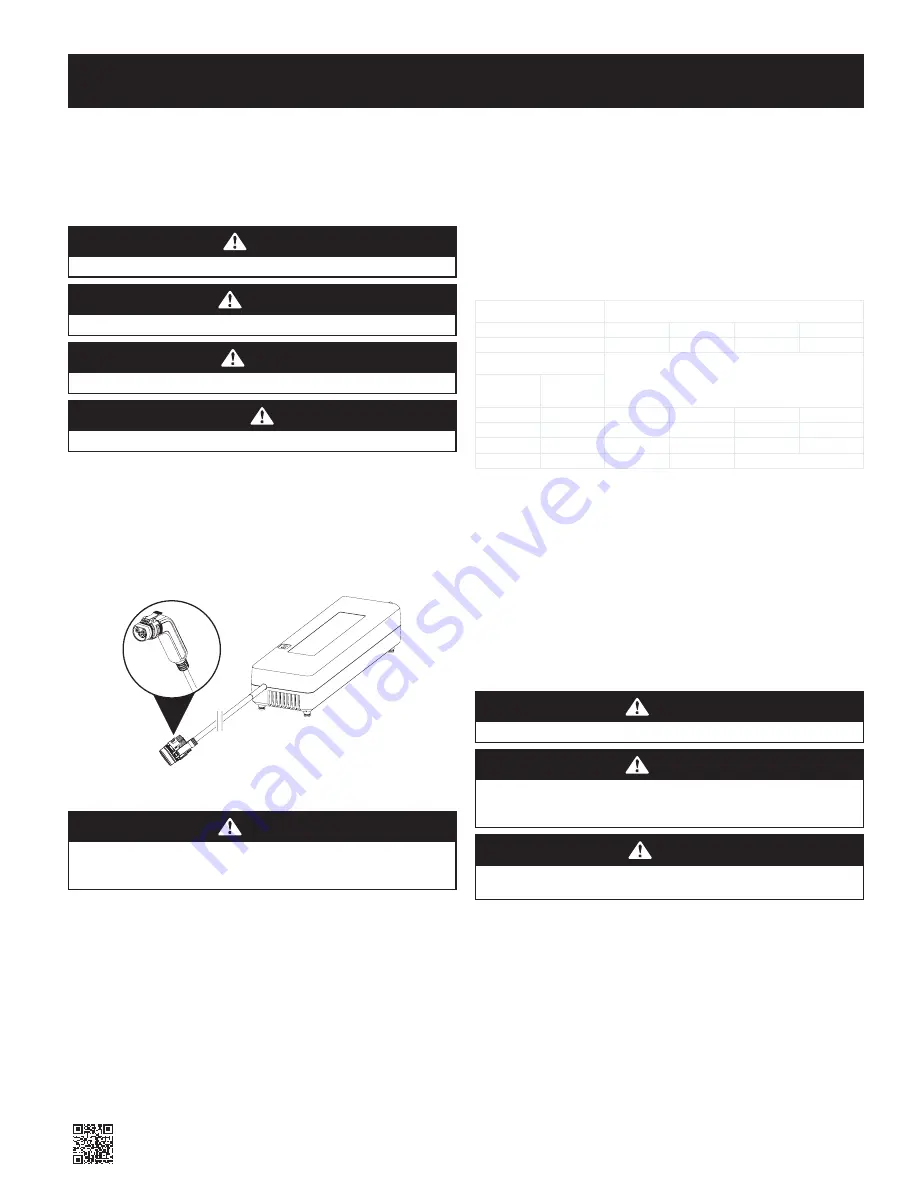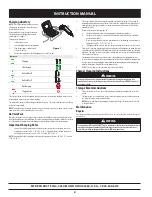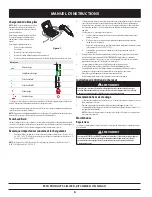
INSTRUCTION MANUAL
1
Definitions: Safety Alert Symbols and Words
This instruction manual uses the following safety alert symbols and words to alert you to hazardous
situations and your risk of personal injury or property damage.
DANGER
Indicates an imminently hazardous situation which, if not avoided, will result in death or serious injury.
WARNING
Indicates a potentially hazardous situation which, if not avoided, could result in death or serious injury.
CAUTION
Indicates a potentially hazardous situation which, if not avoided, may result in minor or moderate injury.
(Used without word) Indicates a safety related message.
NOTE:
Indicates a practice not related to personal injury which, if not avoided, may result in
property damage.
SAVE THESE INSTRUCTIONS:
This manual contains important safety and operating instructions for
battery chargers.
1.
Charger is engaged when charger connection is securely connected to the charger port on the
machine and the charger connection latch is in the closed position.
SAVE ALL WARNINGS AND INSTRUCTIONS
FOR FUTURE REFERENCE
Important Safety Instructions for All Battery Chargers
WARNING
Read all safety warnings, instructions, and cautionary markings for the battery pack, charger, and
machine. Failure to follow the warnings and instructions may result in electric shock, fire, and/or
serious injury.
•
DO NOT attempt to charge the battery pack with any chargers other than the ones
in this manual.
The charger and battery pack are specifically designed to work together.
•
These chargers are not intended for any uses other than charging original
manufacturer rechargeable batteries.
Any other uses may result in risk of fire, electric
shock or electrocution.
•
DO NOT expose the charger to rain or snow.
•
Pull by the plug rather than the cord when disconnecting the charger.
This will
reduce the risk of damage to the electric plug and cord.
•
Make sure that the cord is located so that it will not be stepped on, tripped over or
otherwise subjected to damage or stress.
•
DO NOT use an extension cord unless it is absolutely necessary.
Use of improper
extension cord could result in risk of fire, electric shock or electrocution.
•
An extension cord must have adequate wire size (AWG or American Wire Gauge) for
safety.
The smaller the gauge number of the wire, the greater the capacity of the cable, that
is, 16 gauge has more capacity than 18 gauge. An undersized cord will cause a drop in line
voltage resulting in loss of power and overheating. When using more than one extension to
make up the total length, be sure each individual extension contains at least the minimum
wire size. The following table shows the correct size to use depending on cord length and
nameplate ampere rating. If in doubt, use the next heavier gauge. The lower the gauge
number, the heavier the cord.
Minimum Gauge for Cord Sets
Volts
Total Length of Cord in Feet (Meters)
120V
25 (7.6)
50 (15.2)
100 (30.5)
150 (45.7)
240V
50 (15.2)
100 (30.5)
200 (61.0)
300 (91.4)
Ampere Rating
American Wire Gauge
More Than
Not More
Than
0
6
18
16
16
14
6
10
18
16
14
12
10
12
16
16
14
12
12
16
14
12
Not Recommended
•
DO NOT place any object on top of the charger or place the charger on a soft surface
that might block the ventilation slots and result in excessive internal heat.
Place the
charger in a position away from any heat source. The charger is ventilated through slots on the
side of the housing.
•
DO NOT operate the charger with a damaged cord or plug.
•
DO NOT operate the charger if it has received a sharp blow, been dropped or
otherwise damaged in any way.
Take it to an authorized service center.
•
DO NOT disassemble the charger; take it to an authorized service center when
service or repair is required.
Incorrect reassembly may result in a risk of electric shock,
electrocution or fire.
•
Disconnect the charger from the outlet before attempting any cleaning. This will
reduce the risk of electric shock.
Removing the battery pack will not reduce this risk.
•
NEVER
attempt to connect two (2) chargers together.
•
The charger is designed to operate on standard 120V household electrical power.
DO NOT attempt to use it on any other voltage.
WARNING
Shock hazard. DO NOT allow any liquid to get inside the charger. Electric shock may result.
WARNING
Burn hazard. DO NOT submerge the battery pack in any liquid or allow any liquid to enter the battery
pack. Never attempt to open the battery pack for any reason. If the plastic housing of the battery pack
breaks or cracks, return to a service center for recycling.
CAUTION
Burn hazard. To reduce the risk of injury, charge only original manufacturer rechargeable battery packs.
Other types of batteries may overheat and burst resulting in personal injury and property damage.
NOTE:
Under certain conditions, with the charger plugged into the power supply, the charger can
be shorted by foreign material. Foreign materials of a conductive nature, such as, but not limited to,
grinding dust, metal chips, steel wool, aluminum foil or any buildup of metallic particles should be kept
away from the charger cavities. Always unplug the charger from the power supply when not charging
the machine. Unplug the charger before attempting to clean.
Form No. 769-25899
(October 27, 2020)
120 VOLT LITHIUM-ION BATTERY CHARGER - T56350 SERIES
Summary of Contents for T56350 Series
Page 7: ...NOTES...
Page 8: ...NOTES...


























